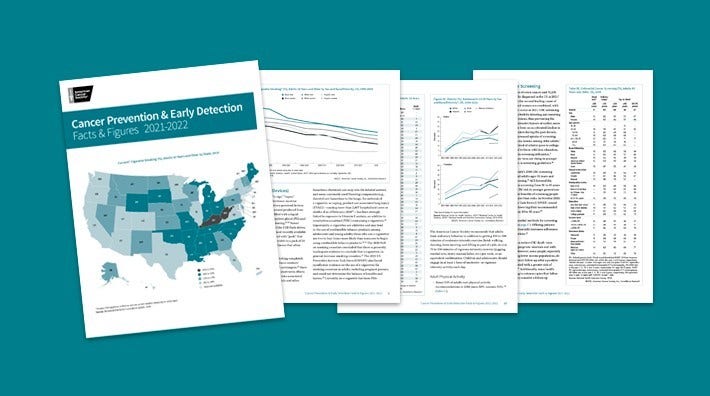Smoking Rates Historically Low, but Other Cancer-related Behaviors Need Improvement
ACS Report: Cancer Prevention & Early Detection Facts & Figures, 2021-2022

The latest statistics about the major cancer risk factors and screening test use in the United States are now available in the journal Cancer Epidemiology, Biomarkers & Prevention and in the American Cancer Report Cancer Prevention & Early Detection Facts & Figures, 2021-2022.
An American Cancer Society (ACS) review of cancer prevention and early detection measures for 2018 and 2019 in the United States shows mixed progress. Smoking prevalence during this time was at an historic low, partly because most people who ever smoked have quit. But obesity rates remained high, and cancer screening and HPV vaccination levels were inadequate to make the desired progress toward a world without cancer. Plus, racial/ethnic and socioeconomic disparities persisted across most major modifiable cancer risk factors and preventive measures.
Every 2 years, researchers from the ACS analyze data from multiple national surveys to understand how many adults in the United States report behaviors that can affect their cancer risk or help find it early—because these efforts are central to reducing the cancer burden.
The current findings are published in the journal Cancer Epidemiology, Biomarkers & Prevention as well as in the ACS report Cancer Prevention and Early Detection Facts & Figures, 2021-2022. The review is one of the only sources that looks at the major modifiable cancer risk factors, in addition to HPV vaccination and cancer screening test use. All data was compiled before the COVID-19 pandemic.
Of the estimated 608,570 deaths from cancer expected to occur in the United States in 2021, about 45% are from potentially preventable causes such as cigarette smoking, excess body weight, alcohol intake, physical inactivity, and unhealthy diet.
“Our snapshot of the status of cancer prevention and early detection measures was mixed,” said ACS researcher Priti Bandi, PhD, who led the study. “Overall cigarette smoking is down, but obesity remains high, and the use of cancer screening and HPV vaccination continues to be underused.” Bandi and her colleagues also found that substantial racial/ethnic and socioeconomic disparities persisted.
Tobacco use and disparities in smoking cessation
Cigarette smoking increases the risk for lung cancer, as well as about a dozen other types of cancer. Quitting smoking reduces the risk of developing all cancers caused by smoking.
Here are some of study’s key statistics from the 2018 to 2019 data for US adults.
- Cigarette smoking reached an historic low in 2019. Yet 14% of the US population (34 million people) still smoke, and smoking accounts for nearly 30% of all deaths from cancer.
- About 62% (55 million) of all people who had ever smoked had quit in 2019. This measure, known as the quit ratio, was lower (<55%) for people with only a high school education or less; lesbian, gay, and bisexual populations; recent immigrants; and people who lived in 12 of the 17 Southern US states. It was even lower (<45%) for people with lower incomes, Black and American Indian/Alaska Native people, and people without health insurance or who were insured by Medicaid.
- Only 62% of Hispanic people who smoked received advice from their doctor to quit, compared to 72% of Black people and 73% of Asian and White people.
- Only 24% of Asian persons and 25% of Hispanic persons used recommended smoking cessation treatments, compared to 30% of Black persons and 36% of White people.
- Recent successful cessation in people insured by Medicaid was about 40% less than among those privately insured, even though they try to quit at similar rates. The proportion of people who smoke who are covered by Medicaid has increased, particularly after the passage of the Affordable Care Act (ACA). In 2013, only 14% of Medicaid recipients ages 18 to 64 who smoked were covered by Medicaid, compared to 21% in 2018. However, only 14 states covered comprehensive smoking cessation treatments as of 2020 for their traditional Medicaid program enrollees, and 11 programs covered these for their ACA expansion enrollees as of 2019.
- Southern US states in general had lower quit ratios, fewer people who had recently quit successfully, and fewer people who used recommended cessation treatments, even though they had similar or higher quit attempt rates compared to other US regions.
“These data highlight the critical importance of expanding tobacco cessation coverage in state Medicaid programs,” Bandi said. The geographic disparities in the South, the authors said, were also potentially related to inequitable distribution of cessation coverage policies, as well as to health care access and evidence-based tobacco control policies.
Promoting state-level population tobacco control policies was one of the key recommendations in the study to reduce the use of tobacco and lessen disparities in smoking cessation. These policies include:
- Increasing the price of cigarettes
- Comprehensive smoke-free policies
- Mass media campaigns
- Cessation programs targeted to lower socioeconomic groups
Excess body weight, physical activity, diet, and alcohol
About 18% of cancer cases in the US can be attributed to a combination of excess body weight, lack of physical activity, unhealthy diet, and consumption of alcohol.
Studies have demonstrated that adults who closely follow the ACS nutrition and physical activity guidelines are less likely to be diagnosed with and die from cancer than those who don’t follow them.
Here are some of review’s key statistics from the 2017 to 2019 data for adults in the US.
- Obesity levels continued to climb, with about 42% of adults ages 20 and above having obesity compared with 23% in 1988-1994. The obesity rate was highest among Black women, at nearly 57%, and lowest—about 17%—among Asian men and women.
- Twice as many adults ate enough fruit as compared to vegetables, but the numbers were still low. Only 26% of adults ate the recommended amount of 2 or more servings of fruit a day, and 13% ate the recommended amount of 3 or more servings of vegetables.
- Over half of those surveyed said they got the recommended levels of physical activity. Yet nearly 1 out of 3 adults said they had no physical activity during their leisure time.
- White and Asian people were more likely to report following a healthy diet and being physically active than Hispanic and Black people.
- About 5% of adults were classified as heavy drinkers. In women, heavier alcohol consumption increased with higher levels of education and income. In men, however, the pattern was reversed; men with less than a high school education and lower income were more likely to be heavy drinkers than those with a college education and higher income.
“It will require collaboration between communities and governments at the national, state, and local levels to take culturally appropriate efforts to reducing the cancer burden in the future,” Bandi said. The study authors recommend these actions:
- Increasing access to affordable, nutritious foods
- Providing safe, enjoyable, and accessible opportunities for physical activity
- Regulating alcohol access
HPV vaccinations and cancer screenings
The human papillomavirus (HPV) vaccine currently used in the US has the potential to prevent about 90% of HPV-caused cancers.
Early detection of cancer through screening reduces death from breast, cervical, colorectal, and lung cancers. Screenings for colorectal and cervical cancer can also prevent these cancers by identifying pre-cancerous areas that can be removed.
Here are some of study’s key statistics from the 2018 to 2019 data.
- HPV vaccination in adolescents, ages 13 to 17, remains underused. Over 40% were not up to date with recommended HPV vaccinations in 2019.
- The number of people who follow cancer screening guidelines has improved in recent years but is still less than ideal. Cervical cancer screening rates in 2018 were the highest, with almost 84% of people ages 21 to 65 having their recommended screening. About 63% of people ages 45 and above followed breast cancer screening guidelines, and 66% of people ages 50 and above followed screening guidelines for colorectal cancer.
- Screening rates were particularly low among people who were uninsured; less than 50% of uninsured persons were up to date with screening recommendations for most cancer types.
To increase the number of people who receive the HPV vaccine in adolescence, the study authors recommend:
- Increasing the number of doctors/providers who recommend it
- Increasing parental awareness
- Increasing access to vaccines by removing administrative and financial barriers
The report notes that recent healthcare reforms, including the ACA Medicaid expansions and elimination of cost-sharing for screenings, have shown promise in helping to reduce screening disparities.
“We can still make substantial progress by promoting smoking cessation among socially vulnerable populations, focusing efforts to stem the rising prevalence of obesity, and improving cancer screening and HPV vaccination levels,” Bandi said.




